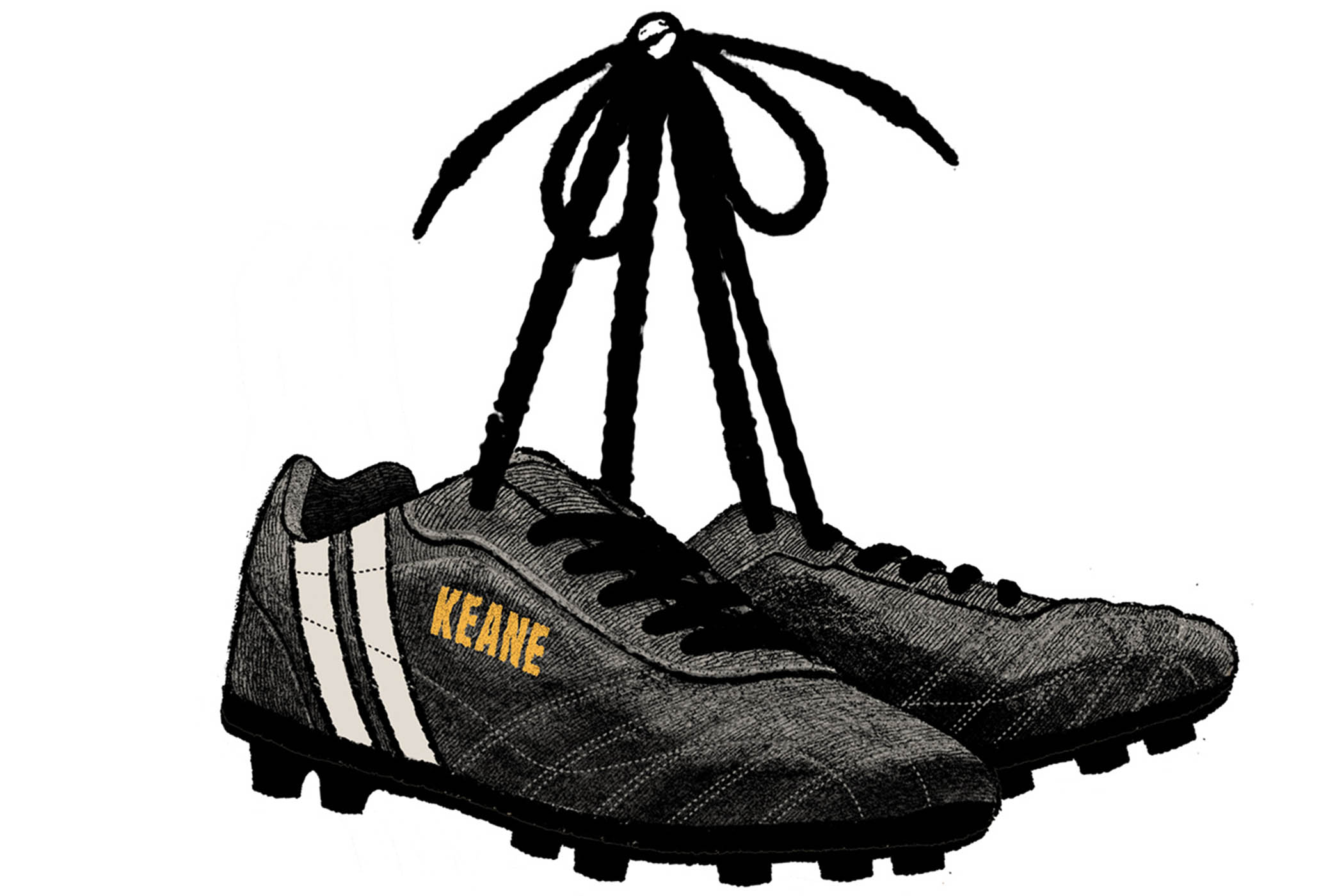Illustration by David Foldvari
There are few things Irish people love more than a nemesis. Little motivates us more than the idea that our success would be spiting some unseen enemy, one who would love to watch our downfall. I’m speaking from personal experience, sure, but I’m certain it’s a shared cultural trait. In a perfect world though, it works best if our enemy is someone markedly different to us – ideally a 17th-century English landowner, who we can despise, rightfully, in perpetuity.
Things become more complicated if the enemy is within. It’s just not as fun to hate on a fellow Irish person, with notable exceptions, of course. It is both fun and morally correct to hate Conor McGregor, for instance, because he is spiritually un-Irish. But occasionally, our national frustrations will land on one who we consider our own, and it will be a difficult and traumatic experience for us all. Such was the case in May 2002, when the entire country briefly turned on its favourite son, Roy Maurice Keane.
Then at the peak of his powers and the captain of the Irish football team, Keane caused an international incident when he abandoned his teammates and Mick McCarthy, the manager he so hated, and returned from a training camp to Ireland, where he announced his refusal to play in the World Cup. His colleagues were left to rot in Saipan, a small island in the middle of the Pacific ocean, where McCarthy had chosen to practise for the tournament. And back in Ireland, everyone lost their minds.
Keane’s rant against McCarthy is preserved like the Irish Magna Carta
Keane said that the national team could “rot in hell”, and that he’d never play for them again. Bertie Ahern, then taoiseach, tried to personally intervene. Peace deals between Keane and McCarthy were brokered in secret, and, in the great tradition of secret Irish peace deals, fell apart before they became public. The papers framed the fallout as a civil war, with families split down the middle on pro and anti-Keane lines. This was The Wind that Shakes the Barley for the Celtic Tiger generation. A Reddit post from last year asking, good-naturedly, which side people fell on, was besieged with comments complaining that it was simply too soon to joke about Saipan.
It is testament to the magnitude of this incident that none of us can bring ourselves to forget it, even today. It’s the same even for those of us, like myself, who were a bit too young to fully grasp the importance of Keane’s very Irish boycott (in fairness, we did invent the word). Everything about the row is preserved in amber for a generation of Irish football fans who know, or at least strongly suspect, that we will never match the success of the 2002 team again. In 2002, Ireland were sent home after a penalty shootout with Spain in the last 16 of the World Cup. Today, Irish football fans would sell their soul to say “we were sent home after a penalty shootout with Spain in the last 16 of the World Cup”. Two decades, evidently, have not made this any less of a bitter pill to swallow.
Even Keane’s entire leaked rant against McCarthy is reverently preserved like the Irish Magna Carta. Here is the transcript, by the way, because it’s just incredibly good: “Mick, you’re a liar. You’re a fucking wanker. I didn’t rate you as a player, I don’t rate you as a manager, and I don’t rate you as a person. You’re a fucking wanker and you can stick your World Cup up your arse. The only reason I have any dealings with you is that somehow you are the manager of my country. You can stick it up your bollocks.” Pure poetry.
It’s little wonder, really, that the fiasco has become a film, less than 25 years after the fact, which is surprisingly quick for historical adaptations even by modern streaming standards. Released as part of this year’s BFI slate, after premiering in Toronto earlier last month, Saipan stars Éanna Hardwicke as Keane and Steve Coogan as McCarthy. Reviews suggest it’s very good (several of its BFI showings are already sold out) but that doesn’t really matter much. What matters is that we still can’t move on from Saipan.
These days, both Keane and McCarthy have very different reputations than they enjoyed in the early 2000s. Today a mellower Keane can laugh with fellow pundit Gary Neville about the time he deliberately stamped on Gareth Southgate (“he deserved it”), or can repackage his misery as memes (he thinks the world’s most overrated things include “fireworks”, “parties” and “smiling”). McCarthy, meanwhile, is probably best known for the video in which he responds to a journalist asking, “One win in 17, it can’t go on like this, can it?” with a grim, “It can.”
In the years after Saipan, being an Irish football fan became very much a game of no smiling, no fireworks, no parties, and a resignation that if you think it can’t get much worse than this, it can. Even in the current World Cup qualifiers, the curse of Saipan lurks around the corner at every turn. For every surprise victory (fine, it was a draw, and fine, it was only against Hungary) there is defeat (who knew Armenia had it in them?). But it wasn’t always like this. In the summer of 2002, there were TVs rolled into classrooms, and there was a decidedly un-Irish optimism in the air that has not returned in the 23 years since. Briefly, we allowed ourselves to have notions.
While I might have missed much of this in 2002 – at the time I was more into Beyblades than football and geopolitics – today I am a Roy Keane superfan. I think he is handsome and I sometimes listen to the Spotify playlists “Roy Keane mood” and “Roy Keane game-day playlist”. I enjoy the video of him stamping on Gareth Southgate. I even enjoy the video of him destroying Alf-Inge Haaland’s right knee. I will be watching, and perhaps rewatching, Saipan. I could probably make the case that Roy Keane would be an impressive taoiseach (certainly a better one than Bertie Ahern). But I will not openly come out one way or the other in the McCarthy-Keane civil war. At least not until we beat Portugal.

